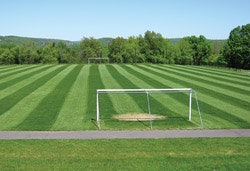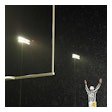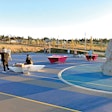As the academic year kicks off this month, a nationwide stampede of student-athletes will put natural grass game fields to their first real tests - ideally - in months. How well they pass those tests, and for how long, will depend on preparation, weather cooperation and ongoing maintenance attention. But make no mistake, the turf is going to take a pounding - particularly in specific and all-too-predictable areas.
 BARE ESSENTIALS Soccer goalmouths need extra attention and at least a couple weeks of rest.
BARE ESSENTIALS Soccer goalmouths need extra attention and at least a couple weeks of rest.And it's in those areas that managers of cool-season turf (warm-season turf is significantly more resilient) should be focusing the bulk of their attention, especially if maintenance budgets tend to run dry. "Don't think of these fields as necessarily being an entire two acres," says Mike Goatley, turfgrass extension specialist at Virginia Tech and the current president of the Sports Turf Managers Association. "Great, if you have that kind of budget. But if you don't, then concentrate your resources where all that traffic is. All you have to do is look out there - it's pretty obvious where all the play is happening. Focus on those areas and try to get those back in game-ready condition."
OFF-SEASON PREP
Special attention to these areas must commence well before the season begins. Goatley, whose research has included examining the effectiveness of turf blankets, notes the 10- to 15-degree difference they can make in soil temperatures and the three- to four-week jumpstart on preferred growing conditions they can provide. "If somebody tells me they can't afford to cover a whole field, I understand, but they could probably afford to do certain areas on the sidelines or to spot-cover a soccer goalmouth. That's always a possibility to at least get some grass back in those most heavily trafficked areas," he says. "I drove by Turner Ashby High School, up in the Shenandoah Valley of Virginia, and their field looked like a runway, with a dark green stripe through the center of the field. They essentially covered hash to hash, goalmouth to goalmouth, and that was strictly to get their cool-season grass up and going again for spring soccer after the wear and tear of the football season."
Goatley preaches field maintenance as a year-round religion. "In Blacksburg, I'm always trying to convince my local high school here that they need to be prepping for the next sport as soon as one sport ends, and it still hasn't sunk in yet. I got a call in July, 'We need to get our field in shape for fall football.' So now here we are in the dead of summer and they've got a cool-season grass, and there's not a lot you can do with cool-season grasses in the summer heat. That should have been done back in the spring."
Likewise, offseason rest, often timed with an aggressive core aeration, is seen as essential by experts, but too often overlooked in real practice. "Soil compaction eventually just becomes absolutely limiting to any type of turfgrass growth," Goatley says. "You just don't have enough oxygen in the soil. So you have to keep soils opened up by working in some type of aeration event into your schedule. It's not a luxury. It's a necessary tool.
"I constantly remind people that it's all about introducing appropriate amounts of oxygen to keep the root system of these grasses happy, and then being realistic about using those fields. If you have the luxury of being able to close fields for a period of a few weeks, take the traffic off of them and give them the tender loving care they need to bring them back, that works like a charm."
The offseason is also the time to fertilize, adds Rossi. "Fertilizing and the right grass is paramount to maximizing the preparation of that system going into the traffic period," he says. "Once that traffic period commences, the only thing that matters is shedding water and throwing seed."
IN-SEASON OVER-SEEDING
Rossi is known for his research into a concept called seed banking - the regular application of fast-germinating seed to high-traffic areas even as they're seeing their heaviest traffic. Applications will vary by circumstance, but weekly over-seeding at a low rate of two pounds per 1,000 square feet is not uncommon, with the understanding that some of the seed will take and some of it won't.
"The focus of compaction and abrasive wear oftentimes exceeds the capacity for that biological system to sustain itself," Rossi says. "If you don't have it at a maximum cover and maximum vigor going into that traffic period, then you have to adapt your system. You have to continue to introduce plants through the regular application of seed to keep pace with the removal of plants by traffic. It's no different than intensive grazing in a farming operation."
Over-seeding can usually keep pace with defoliation down the middle of football fields, says Rossi, but concentrated wear in soccer goalmouths is another story. "In the goalmouths, I believe you can seed only to a certain extent," he says. "If there's no rest, and it's week after week after week of use, you're in the turf-replacement world. At some point, you've exceeded that system's capacity to sustain cover, and you've got to rip it out and put in thick-cut sod so that the people can get back on there and play."
In-season spot aeration, even if it's done using hand tools to break up compacted soils, can help sustain cover longer. However, Rossi draws the line at in-season fertilization. "In our experience, fertilization matters very little," he says. "It's water, seed and eventually sod."
And if all else fails, it's synthetic turf. But Rossi points out that synthetic turf isn't immune to high-traffic issues, either. The key in either case is adherence to a sophisticated maintenance plan that addresses those areas on the field most susceptible to wear. "High traffic is high traffic," Rossi says. "Turf wears out, whether it's plastic or biological. The only way to deal with the abuse that these fields are taking and to keep them as safe as we want them is through a high level of intense maintenance and intervention to prep the field, sustain the field and rehabilitate the field from the use that it gets."
 6 Tips for High Traffic Turf
6 Tips for High Traffic Turf
































